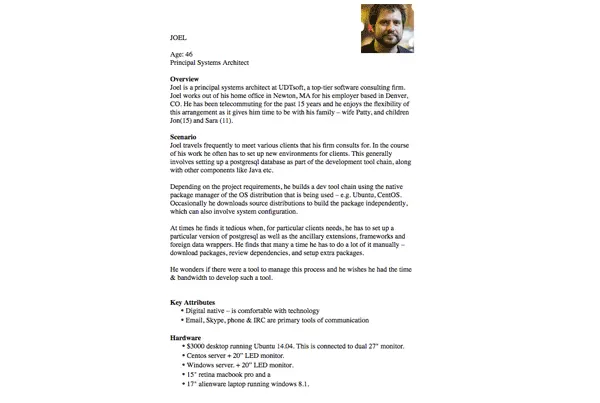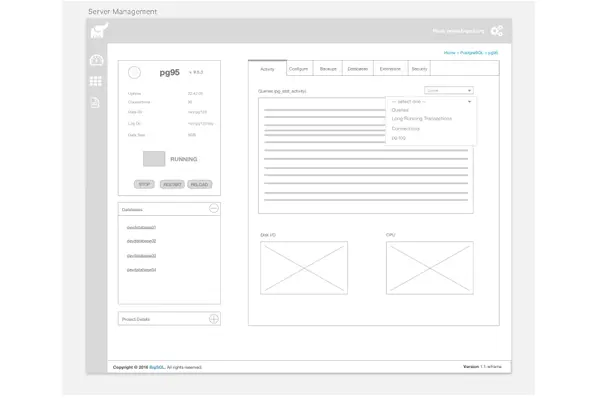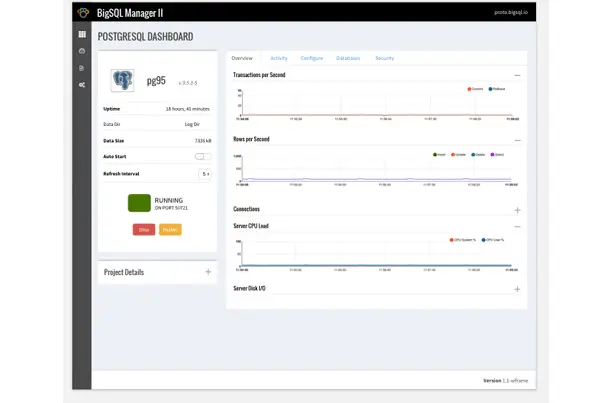BigSQL
UX Portfolio
DB management tool
Solving PostgreSQL's Package Management Problem
The PostgreSQL Ecosystem Gap
PostgreSQL is powerful but fractured. Unlike Node.js with npm or Python with pip, the PostgreSQL ecosystem lacked unified package management. Database administrators were stuck with manual installations, dependency hell, and no centralized way to manage extensions across multiple hosts.
At OpenSCG, we saw an opportunity to build what the community needed: a comprehensive platform that could handle package management, deployment, and multi-host monitoring in one cohesive experience.
My role was dual: shape the product strategy and lead the UX design from concept through launch.
The Challenge: Three Problems, One Solution
We weren't building another database tool - we were solving three fundamental problems:
- Package Management Chaos - No npm equivalent for PostgreSQL extensions
- Installation Friction - Complex setup processes that scared away potential users
- Multi-Host Management - No unified interface for managing distributed PostgreSQL installations
Each problem could justify its own product. The challenge was creating one platform that solved all three without feeling bloated or confused.
Strategy First, Design Second
Before wireframing anything, I led product strategy sessions to define what BigSQL should actually be. This wasn't about adding features to existing tools - it was about reimagining how database management could work.
Strategic decisions:
- Target both novice administrators and PostgreSQL experts
- Prioritize ease of use without sacrificing power user capabilities
- Build for the workflows people actually have, not idealized database administration scenarios
I facilitated workshops with engineering teams, sales, and external PostgreSQL community members to validate our assumptions and refine the product vision.
User Research in a Technical Domain
Database administrators are a specific breed. They value reliability over flashiness, depth over simplicity, and they can smell marketing nonsense from a mile away.
I conducted stakeholder interviews with DBAs, DevOps engineers, and developers across different company sizes. The insights were eye-opening:
- Time sink identification: Routine tasks consumed disproportionate time
- Tool proliferation: Teams cobbled together 5-6 different tools for complete database management
- Onboarding pain: New team members needed months to become productive
- Trust issues: DBAs were skeptical of "simplified" tools that might hide important details

Information Architecture: Organizing Complexity
The IA challenge was massive. We needed to accommodate:
- Package discovery and dependency management
- Installation wizards for various deployment scenarios
- Multi-host monitoring dashboards
- Configuration management across different PostgreSQL versions
- Performance metrics and alerting
I created detailed wireframes that explored different organizational approaches. The breakthrough came when I realized we needed adaptive navigation - the interface should reorganize itself based on whether users were doing package management, installation, or monitoring tasks.
Fighting the Engineering Mindset
This was my biggest challenge. OpenSCG was an engineering-driven company where features often got prioritized over user experience. I had to consistently advocate for user-centered development in an environment that defaulted to technical complexity.
My approach:
- Created HTML prototypes that engineering could interact with and understand
- Used real data and workflows in design reviews to demonstrate user impact
- Established regular check-ins that kept UX considerations visible throughout development
- Built relationships with individual engineers who became UX advocates
Design Process: Bridging Technical and Human
I developed interaction specifications that were detailed enough for engineering implementation but flexible enough to accommodate technical constraints. This meant:
- Wireframes that showed state changes and error conditions
- Prototypes that demonstrated complex workflows end-to-end
- Documentation that explained the reasoning behind design decisions
- Regular design reviews that included both UX and technical validation

Managing Shifting Requirements
Startup life meant constantly changing priorities. Business requirements shifted based on customer feedback, technical constraints emerged during development, and competitive pressures influenced feature decisions.
I handled this through:
- Flexible design systems that could accommodate new features
- Regular stakeholder alignment sessions to reassess priorities
- Modular wireframes that could be recombined as requirements changed
- Clear documentation of design rationale so decisions could be revisited intelligently
The Platform That Emerged
BigSQL became the package manager PostgreSQL never had. Users could:
- Discover and install extensions through an intuitive interface
- Deploy PostgreSQL clusters with one-click installation wizards
- Monitor multiple hosts from a unified dashboard
- Manage configurations across distributed environments
More importantly, it felt like a cohesive product rather than three tools duct-taped together.

What I Learned
Designing for highly technical users requires different skills than consumer UX. You can't hide complexity - you have to organize it intelligently. The best enterprise software makes difficult tasks manageable, not simple.
Working in an engineering-driven environment taught me that UX advocacy is as important as UX design. Sometimes the biggest impact comes from changing how teams think about users, not just what users see on screen.
BigSQL succeeded because we solved real problems for people who knew the difference between good tools and marketing fluff. That authenticity became our competitive advantage.